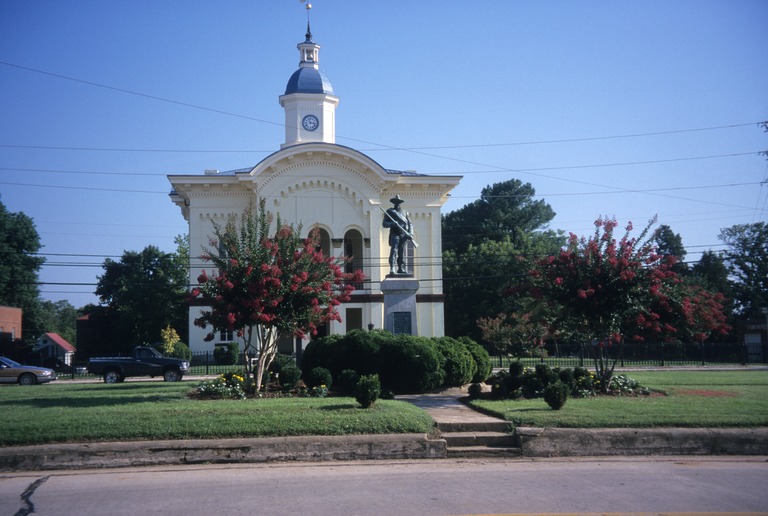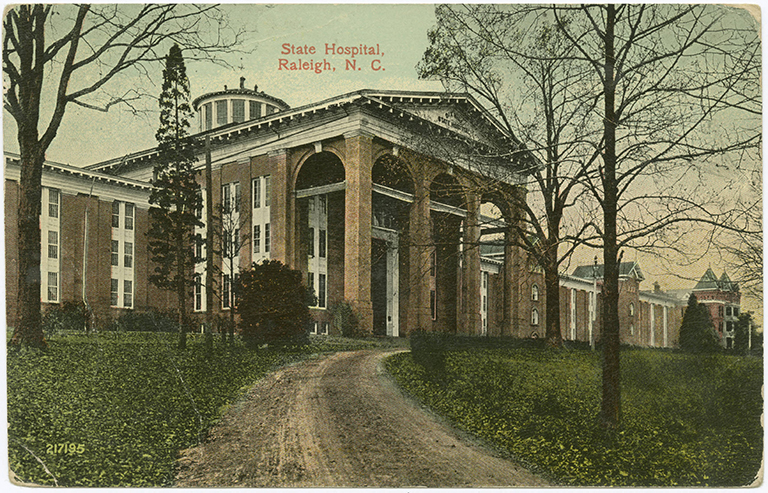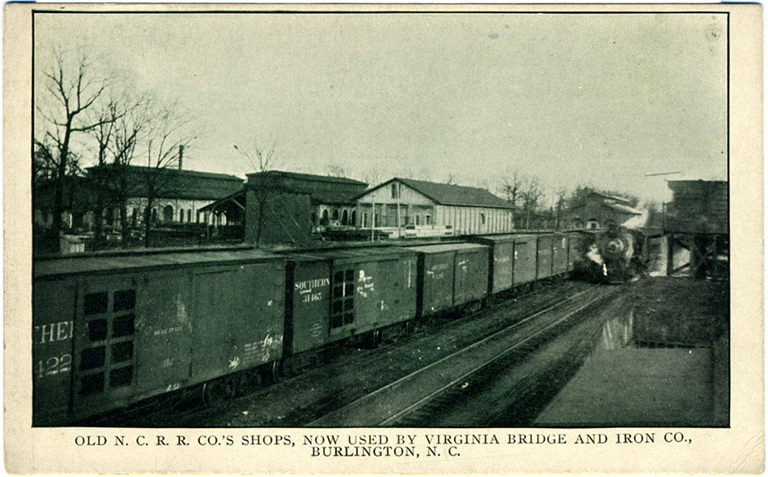McKnight, David (1811-1886)
Birthplace:
Virginia, USA
Residences:
- Winston-Salem, North Carolina
- Greensboro, North Carolina
Trades:
- Brickmason
NC Work Locations:
Building Types:
Styles & Forms:
Greek Revival; Italianate; Tuscan
David McKnight (1811-1886), a native of Virginia who resided in Greensboro and later Winston-Salem, North Carolina, had a long career as a brickmason and contractor in the North Carolina Piedmont. Associated with antebellum progressive leaders in Greensboro including Governor John Motley Morehead, he was involved in major building projects that expressed the spirit of modernity in the late antebellum period, which focused on education, railroads, and stylish architecture including works by architects Alexander Jackson Davis and William Percival. Execution of these large projects, often involving unfamiliar forms and techniques, required competent builders who were also capable managers. McKnight’s repeated success in getting these contracts indicates that he met his clients’ expectations. His postwar work has not yet been identified.
Little is known of David McKnight’s early life in Virginia. In 1839 he married Mary Ann Gafford in Pittsylvania County, Virginia. They evidently moved to the Greensboro area by the early 1840s. The Greensboro Patriot of October 12, 1844, carried a notice announcing the dissolution of a bricklaying business partnership McKnight and Gibson and advising: “Those owing the firm and those having claims against us will please settle with David McKnight.” The United Census of 1850 recorded David and Mary Ann McKnight’s family in Greensboro, with their eldest child, John, aged 7, born in Danville, Virginia, and his sister Caroline, aged 5, born in Guilford County.
When McKnight arrived in Greensboro, its civic leaders including John Motley Morehead (governor from 1841 to 1845) and others were promoting advances in transportation, education, and architecture. These proponents of progress commissioned designs for several buildings, including Morehead’s villa Blandwood (1844), from the influential New York architect Alexander Jackson Davis. McKnight soon became part of this milieu and the contractor for key buildings. No evidence has been found of McKnight having worked at Blandwood, but clearly his association with Morehead later benefited his career.
An account of McKnight’s life in Greensboro appeared in the Rockingham, North Carolina Rocket of September 16, 1886, written by his old friend and former neighbor, the Methodist minister N. H. D. Wilson. The writer recalled McKnight’s “erect form, elastic step, bland smile and cheerful voice.” “As a ‘master builder’ in our town, in Raleigh and other places, the old Edgeworth Seminary, Greensboro Female College, Insane Asylum, &c attest his skill in his trade.” Wilson recalled, “By industry he had supported his family and saved the nucleus of a good provision for old age when the war came and swept it all away.” Although only the “Insane Asylum” has been documented as McKnight’s work, Wilson’s recollection is likely reliable.
The buildings Wilson credited to McKnight were important landmarks of progress in the state. Greensboro’s Edgeworth Female Seminary (established by John Motley Morehead), and the Greensboro Female Academy (now Greensboro College) both reflected local progressive leaders’ emphasis on education for women as well as men. Their main buildings were constructed in the 1840s. Apparently both schools requested designs from A. J. Davis in the early 1850s for additions to their original main buildings. Additional research may reveal which sections of the two schools were built by McKnight.
Morehead was likely instrumental in McKnight’s gaining a large and important commission, the brickwork for the immense North Carolina Hospital for the Insane in Raleigh, a major work by architect A. J. Davis. Former governor Morehead chaired the commissioners for the project and likely influenced the selection of contractors. The North Carolina Standard of June 12, 1850 noted that “Mr. Lane of Rockingham” was already engaged in making bricks, and “Mr. McNight [sic] of Greensborough” was to lay them. Eleazar Colburn of Raleigh had contracted for the stonework. The carpentry contract was later awarded to members of the Conrad Family, who had built Blandwood for Morehead. Brickmason and plastering contractor Dabney Cosby was also involved in the project.
Another large project soon followed—the North Carolina Rail Road Company Shops. The North Carolina Railroad was chartered in 1848 after long campaigning, and its construction from Goldsboro to Charlotte—via Raleigh and Greensboro—proceeded over several years and boosted trade along its route. John Motley Morehead became president. The centrally located Company Shops facility was begun in 1856 to provide repairs on the company’s rolling stock. David McKnight and Joseph A. Houston contracted for the brickwork on the substantial buildings that formed the core of the new railroad town, initially called Company Shops and later Burlington. The carpentry work was contracted by the firm of Ashley and Dudley. The designer of the shops buildings is not known, nor is it known whether McKnight was involved in any of the other picturesque structures associated with the railroad and its leaders.
McKnight’s best known surviving project stands several miles north in the town of Yanceyville: the splendid Caswell County Courthouse designed by architect William Percival as a boldly composed Italian villa format. Percival placed advertisement for bidders on drawings he posted, but no further documentation has been found except for an 1861 notation of a payment of about $25,000 to contractor McKnight for its completion.
McKnight joined in the 1850s with several prominent local citizens as a director of the Greensboro Mutual Insurance Company, which continued for several years despite the Civil War. In 1860 his prosperity was reflected in the United States Census, which recorded him as a mason in Greensboro owning $3,000 worth of real estate and a remarkable $23,500 in personal property, which probably included enslaved workers. His family comprised Mary, aged 40, six children aged from 2 to 18, and Caroline Gafford, aged 55, likely Mary’s mother or sister.
During the Civil War, with construction lagging, McKnight tried gold and copper mining several miles west of Greensboro, joining a company organized by David P. Weir of Greensboro (Greensboro Patriot, June 2, 1864). This project seems not to have thrived long. After the war, in 1866, McKnight was one of three “commissioners” appointed to have the county jail “put in order” and solicit bids for that work, for which plans were to be seen at a local drugstore (Greensboro Patriot, June 1. 1866). No other postwar buildings have been attributed to McKnight. As his friend Mr. Wilson recalled, postwar economic problems plagued McKnight along with other builders and citizens. In 1868 he along with many others was declared bankrupt (Raleigh Daily Standard, April 14, 1868).
Perhaps in hopes of finding work, he moved to Raleigh, where he was working at his old trade and was recorded by the United States Census in 1870. His household included Mary and five children aged 5 to 22, all born in North Carolina. Robert, 22, was a brickmason like his father, and David, Jr., aged 16, was a printer. In 1876, the family was back in Greensboro; in that year, newspapers reported the sudden and unexplained death of David, Jr., a compositor at a Greensboro press office. By 1880, the McKnights had moved to Winston (later Winston-Salem), where David, Sr., continued at the bricklaying business. His household included Mary, their son Edward, a 30-year-old brickmason, and three daughters, all seamstresses.
The Winston-Salem Progressive Farmer of September 8, 1886, announced McKnight’s death on September 6 and described him as having been ten years a resident of that city, “actively engaged as a building contractor and brick mason” and an “estimable gentleman” with “many friends here and in other portions of the State where he is known.” His remains were returned for burial in Greensboro, as were those of his widow when she died in Winston-Salem in 1892. Their son Edward McKnight continued to practice the brickmason’s trade in Winston-Salem and died there in 1925.
- Catherine W. Bishir, North Carolina Architecture (2005).
- Allison Harris Black, An Architectural History of Burlington, North Carolina (1987).
- Edward T. Davis and John L. Sanders, A Romantic Architect in Antebellum North Carolina: The Works of Alexander Jackson Davis (2000).
Caswell County Courthouse
Contributors:David McKnight, contractor; William Percival, architectDates:1858-1860
Location:Yanceyville, Caswell CountyStreet Address:Courthouse Square, Yanceyville, NC
Status:Standing
Type:Public
Images Published In:Catherine W. Bishir, North Carolina Architecture (1990).
Catherine W. Bishir and Michael T. Southern, A Guide to the Historic Architecture of Piedmont North Carolina (2003).
William B. Bushong, “William Percival, an English Architect in the Old North State, 1857-1860,” North Carolina Historical Review, 57.3 (July 1980).
Edgeworth Female Seminary
Contributors:Alexander Jackson Davis, possible architect; David McKnight, brickmasonDates:1840s
Location:Greensboro, Guilford CountyStreet Address:Greensboro, NC
Status:No longer standing
Type:Educational
Note:The seminary was established and owned by John Motley Morehead. Methodist minister N. H. D. Wilson recalled that it was built by David McKnight. An article in the Greensboro Patriot of May 3, 1842, lauded its “extensive” buildings in “fine Architectural taste, erected for the purpose.” In 1853, architect Alexander Jackson Davis was asked to provide a design for the school. He noted in his daybook, May 20, 1853, “Mr. Conrad visited N. Y. I make drawings for Gov. Morehead’s Edgeworth, Greensboro, plan, elev. front rear end on yellow paper, $10.00” (Alexander Jackson Davis Collection, New York Public Library). It is not known whether Davis’s plan was executed. During the Civil War, the school closed and its facilities burned.
Greensboro College
Contributors:Alexander Jackson Davis, possible architect (additions); David McKnight, brickmasonVariant Name(s):Greensboro Female Academy
Dates:1843-1861
Location:Greensboro, Guilford CountyStreet Address:W. Market St., Greensboro College Campus, Greensboro, NC
Status:No longer standing
Type:Educational
Images Published In:Marvin A. Brown, Greensboro: An Architectural Record (1995).
Note:The school was established by Methodists in 1838. Its Main Building was begun in 1843 and opened its doors in 1846. The Greensboro Patriot of Saturday, August 26, 1843, carried an account of the laying of the cornerstone of the Greensboro Female College the previous Saturday. The building was to be 132 feet long and 52 feet high and three stories tall, in “plain” but “durable” style. No mention was made of the architect or builders. It was expanded in sections over several years and burned in 1865. According to Davis and Sanders, A Romantic Architect in Antebellum North Carolina (28), architect Alexander Jackson Davis was asked to provide a design for the school in 1851, but it is not known if such was executed; the Italianate side additions may reflect Davis’s designs. Methodist minister N. H. D. Wilson was surely accurate in crediting construction to David McKnight.
North Carolina Hospital for the Insane
Contributors:Eleazar Colbourn, stone contractor; Conrad Family, contractors; Conrad and Williams, carpentry contractors; Dabney Cosby, brickwork contractor; Alexander Jackson Davis, architect; Stewart Ellison, carpenter; David McKnight, brick contractor; S. L. McKnight, plastering contractorVariant Name(s):Dorothea Dix Hospital
Dates:1850-1852
Location:Raleigh, Wake CountyStreet Address:Dorothea Dix Hospital Campus, Western Boulevard, Raleigh, NC
Status:Altered
Type:Health Care
Images Published In:Catherine W. Bishir, North Carolina Architecture (1990).
Edward T. Davis and John L. Sanders, A Romantic Architect in Antebellum North Carolina: The Works of Alexander Jackson Davis (2000).
North Carolina Rail Road Company Shops
Contributors:Ashley and Dudley, carpenters; William D. Ashley, carpenter; George A. Dudley, carpenter; Joseph A. Houston, brickmason; David McKnight, brickmasonDates:Begun 1856
Location:Burlington, Alamance CountyStreet Address:Webb Ave. at railroad tracks, Burlington, NC
Status:Altered
Type:Transportation
Note:The only remaining building from the many that composed the antebellum repair facility is a much-altered brick foundry. A later survival from the complex is the ca. 1870 Engine House alongside the railroad tracks, a long building of brick laid in 1:4 bond and featuring large windows, buttresses, and a corbeled cornice. See Allison Harris Black, An Architectural History of Burlington, North Carolina (1987) and the Seventh Annual Report of the North Carolina Rail Road, 1856 (Raleigh, Holden and Wilson, 1856).



